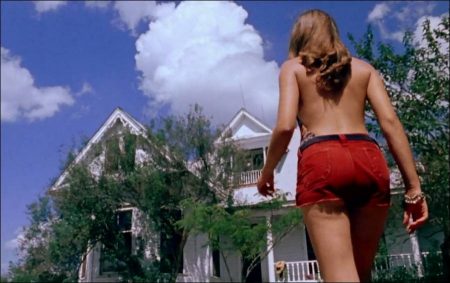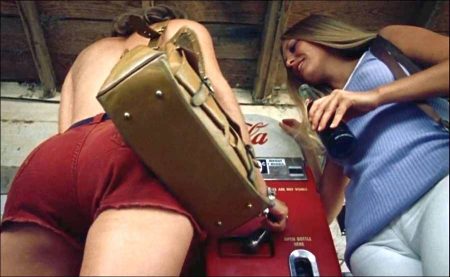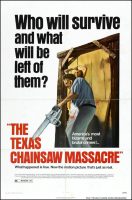Taglines: Wpo will survive and what will be left of them?
The Texas Chain Saw Massacre movie storyline. The year is 1974. A group of five close friends are heading through the back roads of Texas en route to their grandfather’s potentially vandalized grave. Among them are Sally Hardesty, and her invalid brother Franklin. They encounter an unpleasant hitchhiker (Neal) who slashes both himself & Franklin with a wicked-looking knife. The others manage to eject the hitchhiker from the vehicle, but shortly after wards, they are forced to stop & wander over to a small, sinister clapboard house nearby in hopes for gas.
What none of them realize is that this house is the home of the ghoulish Leatherface (Hansen) and his evil, demented family of cannibalistic psychopaths. One at a time, the teens are murdered by the Leatherface in horrifying ways. Sally soon finds herself an involuntary guest at Leatherface’s home, and flees into the night to escape the demented cannibal and his loudly-buzzing chainsaw. Can she escape the grim fate that befell her friends & brother? Based on the terrifying true story of Ed Gein.
The Texas Chain Saw Massacre is a 1974 American slasher film directed by Tobe Hooper and written and co-produced by Hooper and Kim Henkel. It stars Marilyn Burns, Paul A. Partain, Edwin Neal, Jim Siedow and Gunnar Hansen, who respectively portray Sally Hardesty, Franklin Hardesty, the hitchhiker, the proprietor, and Leatherface.
The Texas Chainsaw Massacre follows a group of friends who fall victim to a family of cannibals while on their way to visit an old homestead. The film was marketed as being based on true events to attract a wider audience and to act as a subtle commentary on the era’s political climate; although the character of Leatherface and minor story details were inspired by the crimes of murderer Ed Gein, its plot is largely fictional.
Hooper produced the film for less than $140,000 ($700,000 adjusted for inflation) and used a cast of relatively unknown actors drawn mainly from central Texas, where the film was shot. The limited budget forced Hooper to film for long hours seven days a week, so that he could finish as quickly as possible and reduce equipment rental costs. Due to the film’s violent content, Hooper struggled to find a distributor, but it was eventually acquired by Louis Perano of Bryanston Distributing Company. Hooper limited the quantity of onscreen gore in hopes of securing a PG rating, but the Motion Picture Association of America (MPAA) rated it R. The film faced similar difficulties internationally.
The Texas Chain Saw Massacre was banned in several countries, and numerous theaters stopped showing the film in response to complaints about its violence. While it initially drew a mixed reception from critics, it was highly profitable, grossing over $30 million at the domestic box office, equivalent with roughly over $150.8 million as of 2019, selling over 16.5 million tickets in 1974. It has since gained a reputation as one of the best and most influential horror films.
It is credited with originating several elements common in the slasher genre, including the use of power tools as murder weapons, the characterization of the killer as a large, hulking, faceless figure, and the killing of victims. It led to a franchise that continued the story of Leatherface and his family through sequels, prequels, a remake, comic books and video games.
About the Filming
The primary filming location was an early 1900s farmhouse located on Quick Hill Road near Round Rock, Texas, where the La Frontera development is now located. The small budget and concerns over high-cost equipment rentals meant the crew filmed seven days a week, up to 16 hours a day. The environment was humid and the cast and crew found conditions tough; temperatures peaked at 110°F (43 °C) on July 26. Hansen later recalled, “It was 95, 100 degrees every day during filming. They wouldn’t wash my costume because they were worried that the laundry might lose it, or that it would change color. They didn’t have enough money for a second costume. So I wore that [mask] 12 to 16 hours a day, seven days a week, for a month.”
The Texas Chain Saw Massacre was mainly shot using an Eclair NPR 16mm camera with fine-grain, low-speed film that required four times more light than modern digital cameras. Most of the filming took place in the farmhouse, which was filled with furniture constructed from animal bones and a latex material used as upholstery to give the appearance of human skin. The house was not cooled, and there was little ventilation. The crew covered its walls with drops of animal blood obtained from a local slaughterhouse. Art director Robert A. Burns drove around the countryside and collected the remains of cattle and other animals in various stages of decomposition, with which he littered the floors of the house.
The special effects were simple and limited by the budget.[36] The on-screen blood was real in some cases,[37] such as the scene in which Leatherface feeds “Grandpa”. The crew had difficulty getting the stage blood to come out of its tube, so instead Burns’s index finger was cut with a razor. Burns’s costume was so drenched with stage blood that it was “virtually solid” by the last day of shooting. The scene in which Leatherface kills Kirk with a chainsaw worried actor William Vail (Kirk).
After telling Vail to stay still lest he really be killed, Hansen brought the running chainsaw to within 3 inches (8 cm) of Vail’s face. A real hammer was used for the climactic scene at the end, with some takes also featuring a mock-up. However, the actor playing Grandpa was aiming for the floor rather than his victim’s head. Still, the shoot was somewhat dangerous, with Hooper noting at the wrap party that all cast members had obtained some level of injury. He stated that “everyone hated me by the end of the production” and that “it just took years for them to kind of cool off.”
The Texas Chainsaw Massacre (1974)
Directed by: Tobe Hooper
Starring: Marilyn Burns, Paul A. Partain, William Vail, Allen Danziger, Teri McMinn, Gunnar Hansen, Edwin Neal, Jim Siedow, John Dugan, John Larroquette, William Creamer, Jerry Green
Screenplay by: Kim Henkel, Tobe Hooper
Production Design by: Ron Bozman
Cinematography by: Daniel Pearl
Film Editing by: Sallye Richardson, Larry Carroll
Art Direction by: Robert A. Burns
Makeup Department: W.E. Barnes, W. E. Barnes)
Dorothy J. Pearl
Music by: Wayne Bell, Tobe Hooper
MPAA Rating: None.
Distributed by: Bryanston Distributing Company
Release Date: October 11, 1974
Views: 498



